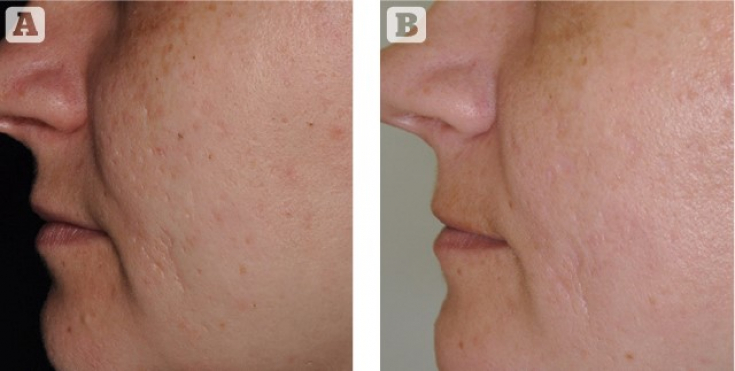The worldwide acne disease is most commonly seen on the face. At the same time, many patients have to fight not only with rashes, but also post-acne scars, the severity of which correlates with the severity of acne.
Scars are formed as a result of skin healing after inflammatory processes. About 60 & ndash; 70% of atrophic post-acne scars & ndash; chipped. They penetrate deep into the dermis and subcutaneous tissue, and therefore are often resistant to traditional grinding methods. Approximately 20–30% are rectangular and 15–25% – rounded atrophic scars. As a rule, various types of scars are presented on the face of the patient.
This article by estet-portal.com presents Dr. Didac Barco's approach to laser resurfacing of post-acne acne using full and fractional modes of CO2-laser.
- Laser resurfacing of post-acne scars: mechanism of action
- Description and results of post-acne therapy with CO2-laser in two modes
- Advantages of CO2-laser resurfacing of post-acne in full and fractional modesmax
Laser resurfacing of post-acne scars: mechanism of action
For post-acne treatment, two categories of lasers are used:
- ablative (classic and fractional);
- non-ablative (classic and fractional).
Classic ablative lasers, considered the gold standard for acne scar resurfacing, provide noticeable improvement after the first session due to:
- collagen contractions;
- skin remodeling;
- skin tightening.
The results of non-ablative lasers are visible after several treatments.
Classic ablative lasers – the gold standard for post-acne scar treatment.
The most effective in the treatment of post-acne among classical ablative lasers is CO2-laser with a wavelength of 10 600 nm (chromophore – water).
Read also: Acne Scar Combination Therapy Protocol: A Case Study
CO2RE (Candela, USA) – it is a CO2 laser with a wavelength of 10600 nm, which can operate in the classic full or fractional modes. Therefore, you can use the modes individually or in combination to get the best effect.
In deep fractional mode, the penetration depth of the radiation is 800 micrometers. High energy and low density avoid excessive heat damage to the skin.
Description and results of post-acne therapy with CO2-laser in two modes
A 31-year-old woman came to the author with complaints of post-acne scars (rectangular, chipped and rounded) on both cheeks (Fig. 1). Previously, the patient did not resort to scar therapy. No comorbidities were found.
Subscribe to our channel in Telegram!
As a correction plan, the author prescribed two sessions of CO2-laser therapy, which were carried out with an interval of 6 months.
Each procedure included:
- limited spot resurfacing in the center and borders of scars in the classic laser mode;
- fractional resurfacing of both cheeks.

Fig. 1: rectangular and chipped acne scars on the left cheek (A) before and (B) after two treatments

Fig. 2: rectangular and chipped acne scars on both cheeks (A) before and (B) after two treatments
Procedure description
30 minutes before the procedure, a mixture of prilocaine 7% and lidocaine 7% was applied to the patient's skin. After that, we performed laser resurfacing post-acne system CO2RE:
- In full mode (3 mJ) – in the center and along the borders of the scars;
- In deep fractional mode (70 mJ) – on scars and adjacent areas of the skin.
Post-procedure care:
- every 12 hours for 7 days, an ointment based on fusidic acid 2.5% was applied to the crusts;
- Epitheliale AH Duo cream (A-derma laboratories) was applied to the skin every 6 hours for 10 days.
Read also: Recommendations for using a CO2 laser
Noticeable improvement occurred 6 months after the first treatment session. At the same time, the second grinding procedure was carried out. On Fig. 2 shows a photo of the patient 3 months after the second treatment session. There were no side effects and complications during the treatment. Advantages of CO
2-laser resurfacing of post-acne in full and fractional modes
The advantage of the presented technique is that it combines:efficiency of classical full resurfacing with CO
- 2
- -laser; limited effect on scars to avoid persistent erythema, hyper- or hypopigmentation and scarring;
- stimulation of collagen synthesis and improvement of skin structure due to fractional resurfacing of a large area of the skin.
- Fully controlled in depth, limited destruction of the epidermis and dermis by classic CO
-polishing provides the best clinical results when working with atrophic post-acne scars. However, the recovery period after such a procedure is quite long and may be accompanied by long-term complications, such as pigmentation disorders, erythema and scarring. Fractional CO2 laser reduces the risk of these adverse events, but is less effective in treating these types of scars.
The combination of full and fractional CO2 laser modes makes resurfacing of atrophic post-acne scars as safe and effective as possible.
You may also be interested in: Topical acne therapy: possibilities and results of application in practice The combined use of full and fractional CO
2laser modes in one procedure allows minimizing the risks and maintaining a high efficiency profile of laser resurfacing of post-acne. According to Prime magazine.
More interesting videos on our





